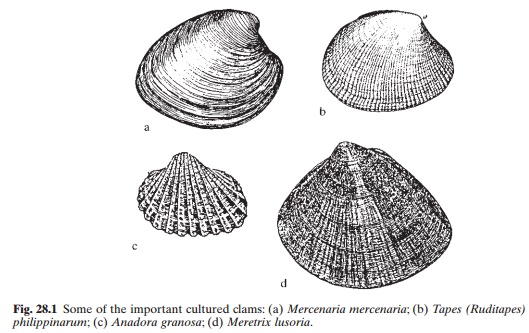Chapter: Aquaculture Principles and Practices: Clams, Scallops and Abalones
Culture systems of Clams
Culture systems
Clam
culture systems closely follow those described earlier for other bivalves. This
also applies to the hatchery methods, which appear to be employed commercially
only in the USA. Like other bivalves, clams also seem to spawn in areas which
are not very suitable for on-growing. So the simplest system of culture
involves the transplantation of seed clams from the spawning areas to growing
beds with sandy bottoms in shallow intertidal areas, which are not exposed for
long periods. This system is widely adopted in Japanese clam culture. Before
the seed are planted, the bottom soil is loosened by a harrow and left
undisturbed for about a week.
Seedlings
are planted by hand, and in temperate climates the best growth is obtained when
they are planted in the spring. Seed is also available in the autumn, and if
necessary planting can be done at this time as well. The stock-

ing
density is roughly 1–4l per m2, but the main consideration is even
distribution and avoidance of crowding. Under Japanese conditions, the market
size of about 10g is reached in between one and two years. Among the major
predators are ducks, starfish, octopus and crabs. Harvesting is performed
throughout the year, removing only the fully grown clams and leaving the
smaller ones for further growth. Hand tools as well as dredges operated from
boats are used for harvesting.
In the
USA, where the hard clam or quahog is commercially cultivated, culture systems
vary from intensive recirculating systems to transplantation of seed clams to
suitable shellfish beds for on-growing. The hard clam has high temperature
tolerance, but grows only in salinities above 20ppt. Seed clams are produced in
several commercial hatcheries in the USA and a clam farmer can obtain his
requirements of seed from them, although many hatcheries use a good part of
their production for on-growing in their own grow-out facilities. A somewhat
unique system of artificial propagation of the small-necked clam (Tapes philippinarum) is carried out in
China (Zong-Qing, 1982). Shallow ponds in the lower intertidal region are
prepared by eradicating pests and predators
and
fertilizing as in normal fish ponds. Selected phytoplankton, such as Chaetoceros, are introduced to produce
enough food for the larvae. Sperm and eggs obtained by induced spawning are
introduced into the ponds, where fertilization and development of embryos take
place. Soybean milk may be added to feed the larvae for faster development. It
is reported that up to 15 million seed clams are thus produced in 1ha of pond
every breeding season.
Related Topics